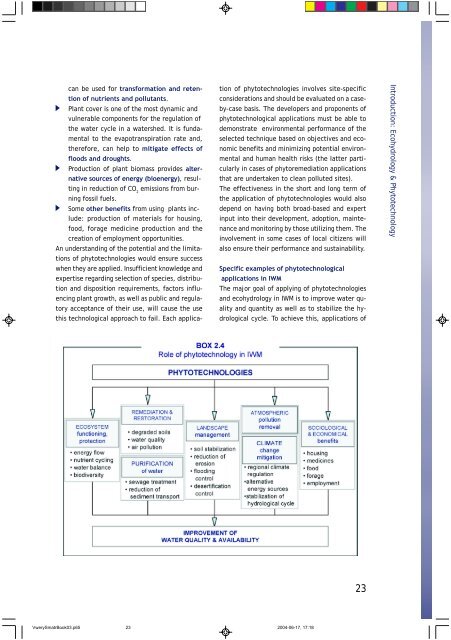Manual - International Environmental Technology Centre
Manual - International Environmental Technology Centre
Manual - International Environmental Technology Centre
Create successful ePaper yourself
Turn your PDF publications into a flip-book with our unique Google optimized e-Paper software.
can be used for transformation and retention<br />
of nutrients and pollutants.<br />
Plant cover is one of the most dynamic and<br />
vulnerable components for the regulation of<br />
the water cycle in a watershed. It is fundamental<br />
to the evapotranspiration rate and,<br />
therefore, can help to mitigate effects of<br />
floods and droughts.<br />
Production of plant biomass provides alternative<br />
sources of energy (bioenergy), resulting<br />
in reduction of CO emissions from bur-<br />
2<br />
ning fossil fuels.<br />
Some other benefits from using plants include:<br />
production of materials for housing,<br />
food, forage medicine production and the<br />
creation of employment opportunities.<br />
An understanding of the potential and the limitations<br />
of phytotechnologies would ensure success<br />
when they are applied. Insufficient knowledge and<br />
expertise regarding selection of species, distribution<br />
and disposition requirements, factors influencing<br />
plant growth, as well as public and regulatory<br />
acceptance of their use, will cause the use<br />
this technological approach to fail. Each applica-<br />
tion of phytotechnologies involves site-specific<br />
considerations and should be evaluated on a caseby-case<br />
basis. The developers and proponents of<br />
phytotechnological applications must be able to<br />
demonstrate environmental performance of the<br />
selected technique based on objectives and economic<br />
benefits and minimizing potential environmental<br />
and human health risks (the latter particularly<br />
in cases of phytoremediation applications<br />
that are undertaken to clean polluted sites).<br />
The effectiveness in the short and long term of<br />
the application of phytotechnologies would also<br />
depend on having both broad-based and expert<br />
input into their development, adoption, maintenance<br />
and monitoring by those utilizing them. The<br />
involvement in some cases of local citizens will<br />
also ensure their performance and sustainability.<br />
Specific examples of phytotechnological<br />
applications in IWM<br />
The major goal of applying of phytotechnologies<br />
and ecohydrology in IWM is to improve water quality<br />
and quantity as well as to stabilize the hydrological<br />
cycle. To achieve this, applications of<br />
VwerySmatrBook03.p65 23<br />
2004-06-17, 17:18<br />
23<br />
Introduction: Ecohydrology & Phytotechnology

















